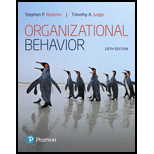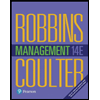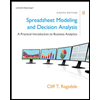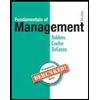
To determine:
The definition of personality, how it is measured and the factors which determine it.
Introduction:
Personality: This refers to the way an individual behaves, interacts, thinks and responds to others to form an individual’s unique characteristics.
Explanation of Solution
Personality defines the way in which an individual responds to and reacts with others. Personality is a very important feature in an individual and every individual is unique in their own way which defines the type of personality they possess.
Personality of an individual is tested in two main ways; self-report surveys and observer-ratings survey.
Self-report surveys is a technique where an individual evaluates his/her own personality type by answering or selecting a series of factors such as; you are a person who finds it difficult to introduce yourself to other people, you normally don’t start conversations etc. This approach is quite helpful for the individual as they themselves assess the answers to the question but however, the answers may be inaccurate or not about the individual if he/she is in a bad mood.
Observer-ratings survey is a technique where an observer rates the individual and comments on his/her behavior and unique characteristics. It’s like a teacher observing their students and commenting on their personality traits, each student would have different personalities. This is likely to guarantee success than self-report surveys because this leads to an individual itself giving in answers to a set of factors.
The factors that determine personality are; heredity and environment. Heredity is the passing of mental or physical characteristics from one generation to another through the biological genes. Normally, an individual’s characteristics is based on their biological parents. Through genes an individual’s personality is possessed, the way the parents react, behave or thinks can be similar to the individual and this is a common factor. But however, it’s not only through the form of genes, the environment in which he/she lives or brought up can also determine the personality. Different cultures have different beliefs and thoughts on certain factors, the religion also does define the personality. As people grow up, their personalities can differ from time to time as they adjust into different environments and cultures with a range of variety of attitudes and characteristics of human beings. There’s a saying “All five fingers aren’t the same”, so therefore every human life living on earth does not possess the same characteristics as everyone else in the universe, each human being is unique in their own ways and the way they believe, behave, react and respond to each other is different.
Want to see more full solutions like this?
Chapter 5 Solutions
Organizational Behavior (18th Edition) (What's New in Management)
- What is a good response to this post? Business Process Reengineering (BPR) is the fundamental transformation of business processes to bring about dramatic performance improvement in areas of critical measurements such as cost, quality, service, and speed. A classic example of successful BPR is Ford Motor Company's reengineering of its accounts payable process. Ford's accounts payable function during the 1980s was labor-intensive and inefficient, employing some 500 workers. The company reengineered this process by implementing an invoice-less system where purchasing orders were put in an online database accessible to both the suppliers and the receiving department. At delivery, the receiving department would compare the goods with the purchase order on the system. When they matched, the system would authorize payment automatically, eliminating manual matching and the associated errors. This reengineering led to a reduction of 75% in the accounts payable personnel, with substantial cost…arrow_forwardWhat are 20 questions I could put on a PAQ when interviewing a training and development specialist?arrow_forwardwaubonsee.instructure.com/courses/23979/assignments/587471 Points 75 C Submitting a file upload Available Jan 21 at 12am - Apr 13 at 11:59pm 2025 Due Sunday by 11:59pm ne ouncements bus Materials (IA) m dules bring: ubonsee bring Services or.com: 24/7 ine Tutoring des 19 ice 365 ogle Drive scussions rary What You Are Doing: Submit a 3-4 page essay comparing and contrasting to texts. These can be short stories, two tv programs, The final assignment should include an MLA formatted outline that includes: 1) Introduction paragraph with a clear thesis 2) Topic sentences for at least 3 body paragraphs that advance your thesis - these are known as the minor claims Include quotes from the text and introduce them with a signal phrase + add an in- text citation. 3) A conclusion that restates your thesis and sums up the points of your paragraphs. 4) Works Cited page that include your two sources/texts AND correctly formatted in MLA (see your textbook NFG P. 548 or LSH P. 150) Prompt For this…arrow_forward
- I need helping creating a Position Analysis Questionaire (PAQ) for the Training and Development Specialist positionarrow_forwardWhat are 4 questions I can put on a PAQ : Information Input SECTION for a training and development specialist?arrow_forwardWhat are the thress levels of social responsibility?arrow_forward
- Discuss how the article aligns with the concept: 1. The development of Legislative Health Policy 2. The Role of research in policy developmentarrow_forwardDiscuss how the article aligns with the concept: 1. The development of Legislative Health Policy 2. The Role of research in policy developmentarrow_forwardYou are part of a team of analysts working for a Caribbean-based investment advisory firm. Your task is to evaluate current investment advice being circulated during the 2025 market downturn and contrast this advice with the Efficient Market Hypothesis (EMH). Your case study is based on the video: Best Strategy to BUY THIS DIP: 2025 Market Crash (Should you DCA or Buy the Dip Lump Sum?!) Analysis of the Video (250–300 words) Summarize the key arguments of the video (Dollar-Cost Averaging vs. Lump Sum). What assumptions does the video make about market behavior and investor actions?arrow_forward
- I'm a senior majoring in Business Management at University. Weakness: Performed all 4 years in my High School’s Talent Show - Situation: - Task: - Action: - Result:arrow_forwardWhat are InnovateTech, a medium-sized technology business, in this strategic effort andoffer a plan for introducing its innovative AI-powered healthcare platform to the North Americanmarket. My main duty as InnovateTech's Senior Marketing Manager would be to oversee thecreation and implementation of this strategic project key processes? Given your strategic initiative, what processes must be done exceptionally well for the strategic initiative to succeed? Given these key processes, what metrics should be used to monitor the execution of these processes? (Key performance indicators typically include measures of customer satisfaction, internal process quality, employee satisfaction, and financial performance.) Monitoring processes and KPIs are part of the control process to achieve goals related to quality and efficiency. Policy creation also supports achieving goals and communicating expectations. For this assignment describe the organization. Then diagram and describe the…arrow_forwardThe Value Chain, Key Performance Indicators (KPIs), and Potential Opportunities for Business Process Reengineering This week’s assignment revisits the strategic initiative proposed in the Module 2 Critical Thinking assignment. What are the organization’s key processes? Given your strategic initiative, what processes must be done exceptionally well for the strategic initiative to succeed? Given these key processes, what metrics should be used to monitor the execution of these processes? (Key performance indicators typically include measures of customer satisfaction, internal process quality, employee satisfaction, and financial performance.) Monitoring processes and KPIs are part of the control process to achieve goals related to quality and efficiency. Policy creation also supports achieving goals and communicating expectations. For this assignment describe the organization. Then diagram and describe the organization’s value chain. Given the strategic initiative, identify key…arrow_forward
 Understanding BusinessManagementISBN:9781259929434Author:William NickelsPublisher:McGraw-Hill Education
Understanding BusinessManagementISBN:9781259929434Author:William NickelsPublisher:McGraw-Hill Education Management (14th Edition)ManagementISBN:9780134527604Author:Stephen P. Robbins, Mary A. CoulterPublisher:PEARSON
Management (14th Edition)ManagementISBN:9780134527604Author:Stephen P. Robbins, Mary A. CoulterPublisher:PEARSON Spreadsheet Modeling & Decision Analysis: A Pract...ManagementISBN:9781305947412Author:Cliff RagsdalePublisher:Cengage Learning
Spreadsheet Modeling & Decision Analysis: A Pract...ManagementISBN:9781305947412Author:Cliff RagsdalePublisher:Cengage Learning Management Information Systems: Managing The Digi...ManagementISBN:9780135191798Author:Kenneth C. Laudon, Jane P. LaudonPublisher:PEARSON
Management Information Systems: Managing The Digi...ManagementISBN:9780135191798Author:Kenneth C. Laudon, Jane P. LaudonPublisher:PEARSON Business Essentials (12th Edition) (What's New in...ManagementISBN:9780134728391Author:Ronald J. Ebert, Ricky W. GriffinPublisher:PEARSON
Business Essentials (12th Edition) (What's New in...ManagementISBN:9780134728391Author:Ronald J. Ebert, Ricky W. GriffinPublisher:PEARSON Fundamentals of Management (10th Edition)ManagementISBN:9780134237473Author:Stephen P. Robbins, Mary A. Coulter, David A. De CenzoPublisher:PEARSON
Fundamentals of Management (10th Edition)ManagementISBN:9780134237473Author:Stephen P. Robbins, Mary A. Coulter, David A. De CenzoPublisher:PEARSON





